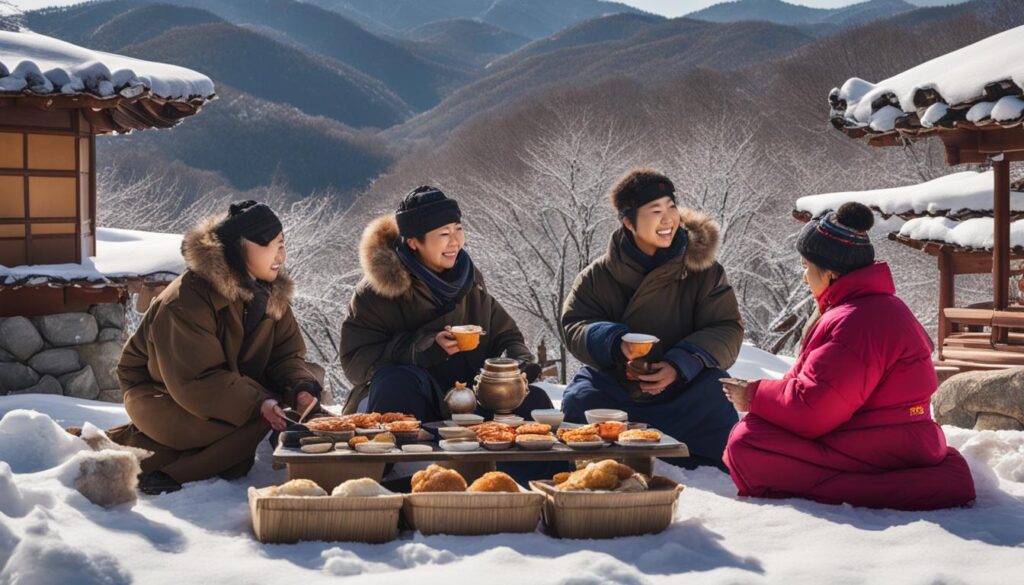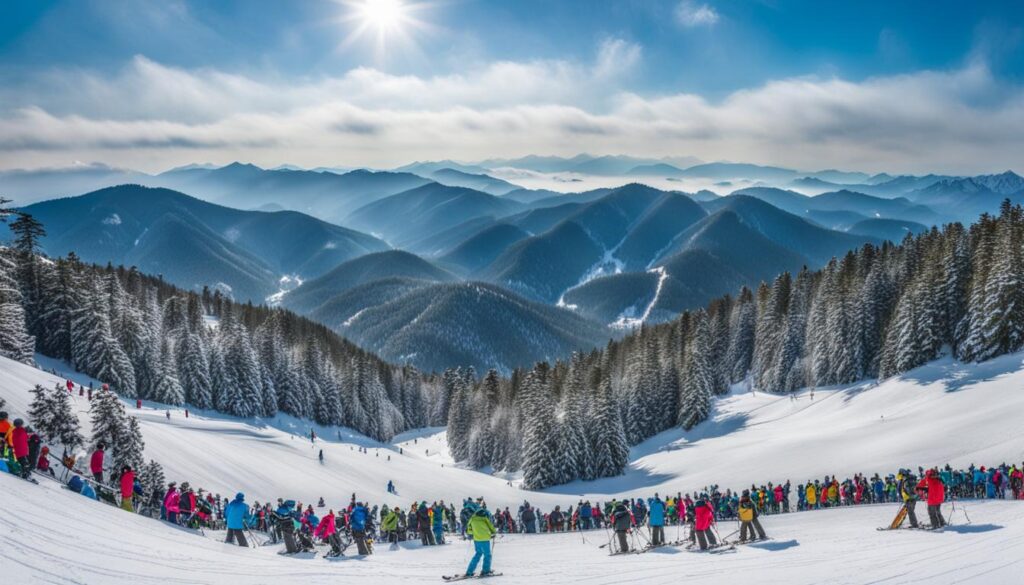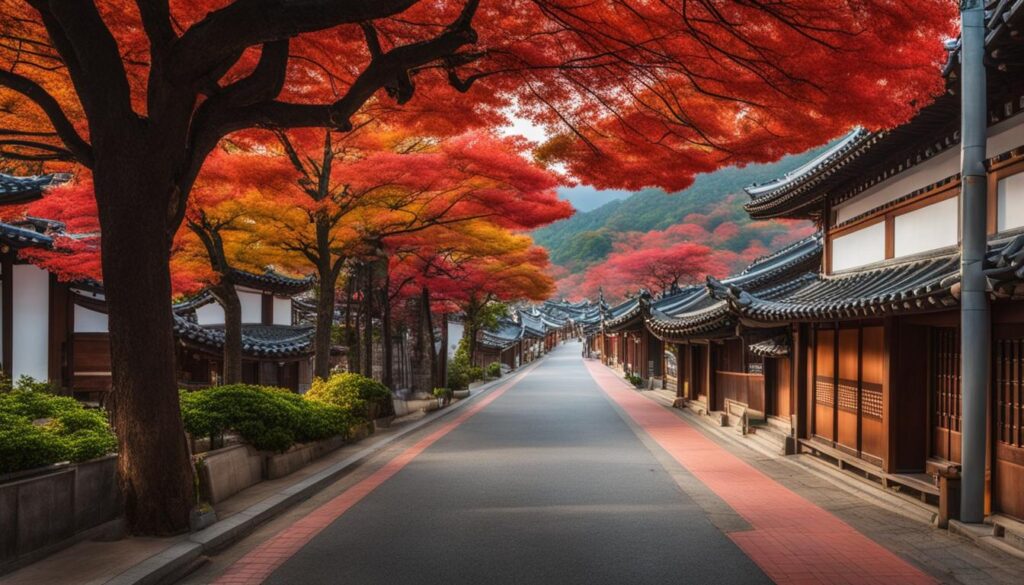If you’re planning a trip to South Korea, you may be wondering when the best time to visit is. With distinct seasons and various festivals and events, deciding on the optimal time to travel can be overwhelming. But don’t worry, we’re here to provide travel tips for South Korea and guide you towards the perfect time to visit.
South Korea is a beautiful country with so much to offer. From the bustling city of Seoul to the stunning natural landscapes, there’s something for every tourist. However, the weather and peak tourist season can impact your experience. Thus, it’s essential to consider the time of year when planning your trip to ensure the best possible vacation.
In this section, we will explore the best time to visit South Korea, taking into account the country’s seasons, weather, and peak tourist season. By the end of this article, you’ll be an expert on the best time to visit South Korea, ready to plan your adventure without any hiccups. So, what is the best time to visit South Korea? Let’s dive in.
Understanding the Seasons in South Korea
If you’re planning a trip to South Korea, understanding the distinct seasons is crucial for a memorable experience. South Korea experiences four distinct seasons that impact the weather patterns and the activities you can enjoy during your trip.
Spring
Spring in South Korea is a picturesque season with blooming cherry blossoms and ideal temperatures. During this season from March to May, the temperatures range between 11°C to 19°C, perfect for outdoor activities such as hiking and exploring the country’s numerous parks. Spring is also the time for outdoor festivals, cherry blossom festivals celebrated throughout the country, and Buddha’s birthday in May.
Summer
Summer in South Korea is warm and humid, with average temperatures ranging from 22°C to 28°C. Despite the heat, summer is a popular season for tourists, especially those who love beaches and watersports. South Korea offers some picturesque beaches like Haeundae in Busan and Songjeong in Daegu. The Boryeong Mud Festival is another popular event celebrated in July.
Autumn
Autumn in South Korea is a season of beautiful colors. From September to November, the temperatures are mild and range between 7°C to 20 °C. Autumn foliage transforms the country into a wonderland of colors, attracting tourists from around the world. Some of the popular spots for autumn foliage are Naejangsan and Seoraksan National Parks. Along with the beautiful landscapes, Autumn is also the time of the Chuseok harvest festival in September and National Foundation Day in October.
Winter
Winter in South Korea is chilly and snowy, with temperatures ranging from -6°C to 7°C. Winter sports enthusiasts flock to the country for skiing, snowboarding, and ice skating, among other activities. South Korea’s ski resorts are renowned worldwide for their beautiful scenic views. The Korean New Year celebrated in January or February is a vibrant festival with lots of traditional events.
With an understanding of the weather patterns, you can choose the season that suits your preferences best. You can pack appropriately and take advantage of the country’s seasonal events and activities to have an unforgettable experience in South Korea.
Spring: Cherry Blossoms and Perfect Temperatures
In South Korea, spring brings the beautiful sight of cherry blossoms in full bloom. During this season, the country is blessed with ideal temperatures ranging from 12 °C to 18 °C, making it a perfect time to explore the country’s stunning natural beauty. The spring season in South Korea usually starts from mid-March and lasts till June. However, the best months to witness the blooming cherry blossoms are April and May.
“Spring in South Korea is a must-see for all nature lovers, as it offers a delightful experience with the cherry blossoms in full bloom.”
The picturesque blooms of cherry blossoms can be spotted in almost every corner of the country, especially in Seoul’s Yeouido Spring Flower Festival that usually takes place in late April. In addition, visitors can also witness the Gurye Sansuyu Blossom Festival in the southern part of the country which is another popular spring festival. Besides, spring is also an ideal time to experience the country’s stunning gardens, visit local villages and enjoy scenic mountain hikes. Don’t forget to pack your camera to capture the wonderful sights of spring in South Korea.
Summer: Beaches and Festivals
If you’re looking for a summer getaway filled with beaches and festivals, South Korea should be at the top of your list. With its gorgeous coastline and exciting events, South Korea is the perfect summer destination.
One of the most popular beach destinations is Haeundae Beach, located in Busan. With its sandy shores and turquoise waters, it’s no surprise that millions of tourists flock to this beach every year. If you’re looking for a quieter option, head to Gyeongpo Beach in Gangneung. With its tranquil atmosphere, this beach is the perfect place to relax and unwind.
And what’s summer without festivals? The Boryeong Mud Festival, held in July, is one of the biggest and most unique festivals in South Korea. Participate in mud wrestling, mud sliding, and even mud painting at this family-friendly event. For music lovers, the Ultra Korea Festival is not to be missed. Held in August, this three-day electronic dance music festival attracts some of the world’s top DJs and music fans.
Don’t forget to pack sunscreen and your swimsuit for a fun-filled summer adventure in South Korea.
Autumn: Colors of Fall and Harvest Festivals
Autumn in South Korea is a truly magical time, as the country transforms into a sea of vibrant colors. The leaves on the trees turn into various shades of orange, yellow, and red, creating a breathtaking sight for both locals and visitors. The best time to witness this natural phenomenon is from mid-September to November, depending on the region.
To experience the full beauty of autumn in South Korea, we recommend visiting one of the country’s many national parks, such as Seoraksan National Park or Naejangsan National Park. Trekking through the mountains and forests, you will be surrounded by the stunning colors of fall and fresh air.
In addition to the natural beauty, autumn is also the time for traditional harvest festivals. One of the most famous festivals is the Andong Mask Dance Festival, which takes place in Andong City in late September or early October. Visitors can enjoy traditional performances and street parades while immersing themselves in Korean culture. The Jinju Lantern Festival is another popular event, showcasing thousands of lanterns along the Namgang River in Jinju City. This festival typically takes place in early October.
Festivals and Events in Autumn:
| Festival/Event | Date | Location |
|---|---|---|
| Andong Mask Dance Festival | September/October | Andong City |
| Jinju Lantern Festival | October | Jinju City |
| Jeju Fire Festival | October | Jeju Island |
Whether you choose to witness the autumn foliage or immerse yourself in traditional Korean festivals, autumn is a fantastic time to visit South Korea. Just remember to pack warm clothing, as temperatures can drop during this season.
Winter: Snowy Landscapes and Winter Sports
South Korea’s winter season offers a picturesque landscape covered in snow, making it an ideal destination for winter sports enthusiasts. You can try skiing, snowboarding, and sledding to satiate your thrill-seeking desires. Some of the best ski resorts in South Korea are Vivaldi Park Ski World, Yongpyong Ski Resort, and High1 Ski Resort.
If you are not into skiing, there are other winter activities you can enjoy, such as snowshoeing, ice fishing, and exploring the winter wonderland scenery in national parks like Seoraksan and Mt. Taebaek. These activities are sure to provide you with a unique and unforgettable experience.
So pack your winter gear and prepare yourself for an adventurous trip to South Korea this winter season!
Peak Season: When to Expect Crowds
If you’re planning a trip to South Korea, you should be aware of the peak season, which occurs between late March and early May, and again from late September to early November. During these times, the country experiences an influx of tourists, leading to crowded popular destinations and longer wait times for attractions.
If you’re traveling during the peak season, it’s recommended to book accommodations and transportation well in advance to ensure availability. Additionally, consider visiting popular destinations during the weekdays instead of weekends, when they tend to be less crowded.
Tip: To avoid crowds altogether, consider traveling during the off-peak season.
“The cherry blossoms in South Korea are a beautiful sight to behold, but be prepared for the crowds during peak season!” – Park Seo-Joon
Off-Peak Season: Avoiding the Crowds
If you’re not a fan of crowds, traveling during the off-peak season in South Korea could be the perfect solution for you. Generally, off-peak season refers to the months that experience low tourism and, as a result, lower prices. You can enjoy a variety of activities without the hustle and bustle of peak season.
The off-peak season in South Korea varies depending on the region, but in general, the months of March to May and September to November are considered the best times to visit. During these months, you can expect fewer crowds, comfortable temperatures, and beautiful scenery.
Advantages of Traveling in the Off-Peak Season
- Avoid the crowds and long waiting times at popular tourist sites
- Save money on accommodations, flights, and attractions
- Experience a more relaxed and authentic local atmosphere.
Traveling in the off-peak season also allows you to take advantage of better deals on accommodations and attractions. You don’t have to compete with other tourists during the peak season, meaning you’ll have more options to choose from and potentially better prices.
“Traveling to South Korea in the off-peak season is like discovering a secret world of beauty and wonder. You’ll have the opportunity to explore without feeling hurried or overcrowded.”
Important Considerations
Keep in mind that the off-peak season in South Korea may also have its own disadvantages. For example, some attractions and businesses may close during the offseason, and the weather may not be as favorable as during peak season. However, with careful planning and preparation, these challenges can be easily overcome.
When packing for your trip during the off-peak season, be sure to bring layers in case of fluctuating temperatures and rain gear in case of unexpected showers. Check weather forecasts ahead of time and plan accordingly to ensure an enjoyable and comfortable trip.
Weather Considerations and What to Pack
South Korea experiences four distinct seasons, each with its own weather patterns. Understanding the climate during your visit will help you pack appropriately and ensure a comfortable trip. Here are some tips on what to pack based on the season you plan to visit:
| Season | Weather | What to Pack |
|---|---|---|
| Spring (March-May) | Mild temperatures with occasional rain | Light layers, waterproof jacket, comfortable walking shoes, and an umbrella |
| Summer (June-August) | Warm and humid with occasional rainstorms | Light clothing, sunglasses, sunscreen, a hat, insect repellent, and a reusable water bottle |
| Autumn (September-November) | Cooler temperatures with occasional rain | Layered clothing, a light jacket, comfortable walking shoes, and an umbrella |
| Winter (December-February) | Cold and dry with occasional snow | Warm clothing, thermal layers, a heavy coat, gloves, a scarf, a hat, and waterproof boots |
Whether you’re exploring the city or enjoying outdoor activities, comfortable walking shoes are a must-have for any trip to South Korea. Additionally, it’s always a good idea to bring a small backpack for daily essentials and a camera to capture unforgettable moments.
Don’t forget to check the weather forecast before your trip and pack accordingly. By preparing for the climate, you can focus on enjoying your South Korean adventure.
Cultural Festivals and Events
South Korea is a fantastic destination for tourists who are looking to experience a unique culture and attend lively festivals and events. The country celebrates numerous festivals throughout the year, ranging from traditional and historical events to modern and artistic exhibitions. These festivals offer visitors a fascinating insight into Korean traditions, customs, and lifestyle.
1. Boryeong Mud Festival
The Boryeong Mud Festival is an annual event held in Boryeong, a coastal city south of Seoul. This festival is celebrated in July and attracts over 2 million visitors from around the world, who come to enjoy the therapeutic properties of the mud from Boryeong’s mud flats. The festival offers various activities such as mud wrestling, mud sliding, and a mud obstacle course.
2. Busan International Film Festival
The Busan International Film Festival is one of the most significant film festivals in Asia and is held annually in the city of Busan. This festival, which started in 1996, attracts movie lovers, filmmakers, and celebrities from around the world. The festival aims to promote Asian films and to provide a platform for up-and-coming directors and actors.
3. Jeju Fire Festival
The Jeju Fire Festival is an annual event that takes place in Jeju Island, South Korea in March. This festival is known for its traditional fire games, including a fire parade, and fire performances. This festival serves as a reminder of Jeju’s unique and mysterious culture.
4. Andong Mask Dance Festival
The Andong Mask Dance Festival is held in the city of Andong, South Korea, in late September or early October. This festival serves as a showcase of traditional Korean mask dance performances, which are famous for their exciting and colorful representations of Korean folklore.
5. Seoul Lantern Festival
The Seoul Lantern Festival is a magnificent display of light and colors that takes place during the end of the year, typically between November and December. The festival features an array of lantern artwork from not just Korea, but other countries also, displayed along the riverside of the city center. It offers an incredible photo opportunity for visitors.
6. Jinju Namgang Yudeung Festival
The Jinju Namgang Yudeung Festival is an annual event held in Jinju, South Korea in October, allowing visitors to witness one of the most exquisite and captivating lantern displays in the country. The festival’s highlight is the floating lanterns on the Namgang River, which sets the river feeling serene and tranquil.
7. Gwangju World Kimchi Culture Festival
The Gwangju World Kimchi Culture Festival, which takes place in the city of Gwangju, is an annual event celebrating Korea’s famous side dish, Kimchi. This festival boasts various Kimchi competitions, exhibitions, exhibitions, and entertaining performances, reflecting the importance of this staple in Korean cuisine in Korean culture.
8. Pusan International Fireworks Festival
The Pusan International Fireworks Festival is one of South Korea’s most spectacular events, celebrated with music, dance, and cultural performances. The festival’s highlight is large-scale firework displays, ranging from small handheld displays to large synchronized fireworks shows, lighting up Pusan’s impressive skyline while creating a mesmerizing atmosphere.
If you’re planning your visit to South Korea, make sure to check out these festivals to experience first-hand what the country has to offer.
Conclusion
Planning your trip to South Korea requires careful consideration of the country’s seasons, peak times, and weather patterns. By taking into account your personal preferences and desired experiences, you can determine the best time to visit this beautiful country and create an unforgettable adventure.
Whether you’re looking to witness the vibrant cherry blossoms in spring, soak up the sun on South Korea’s beautiful beaches during summer, witness the stunning fall foliage and harvest festivals in autumn, or hit the slopes for winter sports in winter, there’s something for everyone.
Don’t forget to keep in mind the peak season when planning your trip, as well as the off-peak season, which can offer a more affordable and quieter experience. And make sure to pack accordingly for South Korea’s weather patterns, which vary greatly between the seasons.
Finally, be sure to check out some of South Korea’s unique cultural festivals and events during your trip, from the colorful lantern festivals to the exciting Boryeong Mud Festival.
With careful planning and research, you’re sure to have an incredible experience in South Korea, no matter when you decide to visit.















































